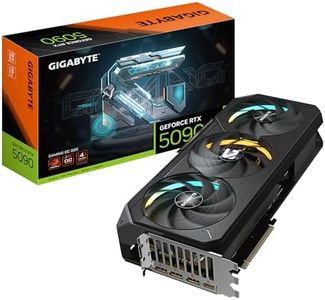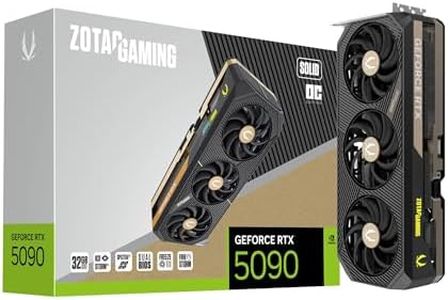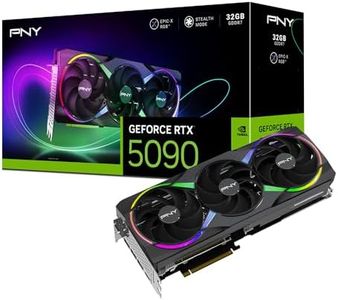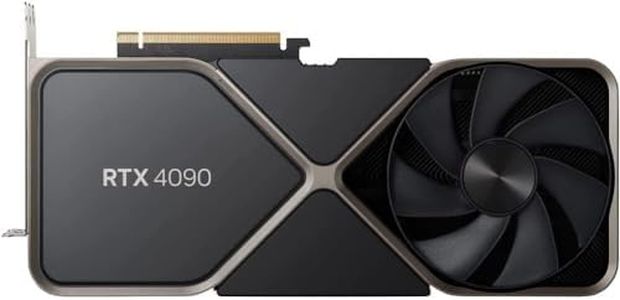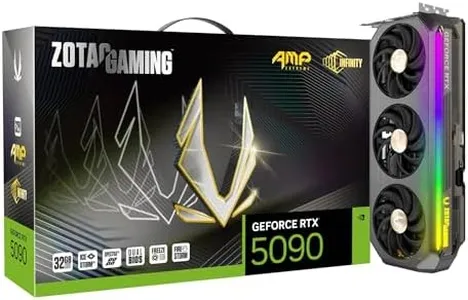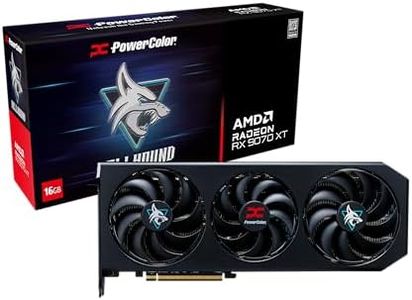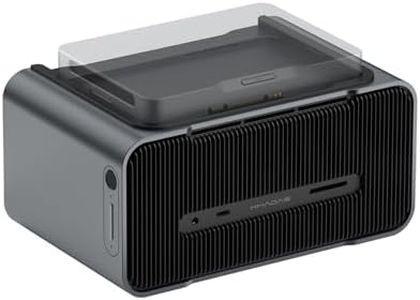10 Best Graphics Cards 2025 in the United States
Our technology thoroughly searches through the online shopping world, reviewing hundreds of sites. We then process and analyze this information, updating in real-time to bring you the latest top-rated products. This way, you always get the best and most current options available.

Our Top Picks
Winner
Gigabyte GeForce RTX 5090 Gaming OC 32G Graphics Card - 32GB GDDR7, 512bit, PCI-E 5.0, 2550MHz Core Clock, 3 x DP 2.1a, 1 x HDMI 2.1b, NVIDIA DLSS 4, GV-N5090GAMING OC-32GD
Most important from
59 reviews
The Gigabyte GeForce RTX 5090 Gaming OC 32G is a high-end graphics card designed for users who want top performance for gaming or heavy creative work. It features a powerful NVIDIA GeForce RTX 5090 GPU combined with a large 32GB of the latest GDDR7 video memory, which allows it to handle very demanding graphics tasks and high-resolution displays up to 7680x4320 pixels. The 2550MHz core clock speed ensures smooth performance, while the wide 512-bit memory interface supports fast data flow. Cooling is well-managed by Gigabyte’s WINDFORCE system, which uses multiple fans to keep temperatures down even under heavy load, with the option to switch between performance and silent modes thanks to its dual BIOS feature.
RGB lighting adds a stylish touch, and the reinforced structure with a VGA holder improves durability and prevents sagging. It connects via PCI Express 5.0 and offers three DisplayPort 2.1a and one HDMI 2.1b ports, giving plenty of options for multiple or high-resolution monitors. At about 4.4 pounds, it's a sizable card, so ensure your PC case has enough space and your power supply can handle its demands.
This card is an excellent choice for gamers and professionals needing extreme graphic power, though the large VRAM and advanced features may be more than what casual users require. It comes with a 4-year warranty after online registration, providing good peace of mind. It is best suited for those seeking one of the latest, most powerful GPUs and are ready to invest in a premium setup.
Most important from
59 reviews
ZOTAC Gaming GeForce RTX 5090 Solid OC DLSS 4 32GB GDDR7 512-bit 28 Gbps PCIE 5.0 Gaming Graphics Card, IceStorm 3.0 Advanced Cooling, Spectra 2.0 ARGB Lighting, ZT-B50900J-10P
Most important from
63 reviews
The ZOTAC Gaming GeForce RTX 5090 is a high-end graphics card designed for serious gamers and content creators who need top performance. It features a powerful NVIDIA GPU with 32GB of the latest GDDR7 memory, which means it can handle very demanding games and 3D applications smoothly, especially at high resolutions like 8K. The boost clock speed of 2422 MHz helps deliver fast and responsive graphics. To keep things cool during heavy use, it comes with IceStorm 3.0 cooling technology, including three large fans and a vapor chamber, which helps prevent overheating and maintain stable performance. Lighting fans and a metal backplate add a premium feel and durability.
It supports multiple monitors with three DisplayPort 2.1 and one HDMI 2.1 ports, making it versatile for gaming setups or professional workflows requiring multi-display support. One thing to keep in mind is the card’s large size and significant power consumption, so users need a compatible PC case and a strong power supply. The dual BIOS feature offers flexibility for different performance profiles.
This card is well suited for high-end gamers or professionals looking for top-tier performance and advanced cooling, but it may be more than necessary for casual users or those with limited PC space.
Most important from
63 reviews
PNY NVIDIA GeForce RTX™ 5090 Epic-X™ ARGB OC Triple Fan, Graphics Card (32GB GDDR7, 512-bit, Boost Speed: 2625 MHz, PCIe® 5.0, HDMI®/DP 2.1, 3.5-Slot, NVIDIA Blackwell Architecture, DLSS 4)
Most important from
81 reviews
The PNY NVIDIA GeForce RTX 5090 is a high-end graphics card designed for gamers and creators who want top-tier performance. It features a powerful NVIDIA GPU with 32GB of fast GDDR7 VRAM, which is excellent for running demanding games, 3D design, and video editing at very high resolutions, even up to 8K. The card runs at a memory speed of 2017 MHz, ensuring smooth and fast processing of visuals. Its triple-fan cooling system and 3.5-slot form factor help manage heat effectively, although the larger size means you should check if it fits your PC case. Connectivity options include the latest DisplayPort and HDMI 2.1, supporting multiple high-resolution monitors and advanced displays. The card uses PCIe 5.0, which is future-proof for newer motherboards.
PNY’s RTX 5090 also includes NVIDIA’s DLSS 4 and Reflex 2 technologies, which use AI to boost game framerates, reduce lag, and improve responsiveness—great for competitive gaming and immersive experiences. The card’s 5.29-pound weight reflects its solid build and advanced cooling. On the downside, such a powerful card likely requires a substantial power supply and generates more heat compared to mid-range models, which could mean higher electricity use and the need for good case ventilation. Additionally, its premium price and size might be more than casual gamers or general users need.
This card is best for serious gamers and creative professionals seeking exceptional performance and the latest AI-driven gaming enhancements, provided they have the right PC setup to support its power and size demands.
Most important from
81 reviews
Buying Guide for the Best Graphics Cards
Choosing the right graphics card can significantly enhance your computer's performance, especially for gaming, video editing, and other graphics-intensive tasks. The key is to understand your needs and match them with the specifications of the graphics card. Here are the main specs to consider when selecting a graphics card and how to navigate them.FAQ
Most Popular Categories Right Now
